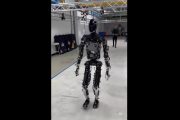
John Cryan, the CEO of Deutsche Bank, the world’s 16th largest bank, gave advance warning about the avalanche of pink slips that were coming. In September, without divulging just how many were coming, the blunt-spoken Cryan told Financial Times’ Laura Noonan that it would be a “big number.” On Wednesday he made it much clearer just how big that “number” is going to be: ”We employ 97,000 people. Most big peers [our competition] have more like half that number.”
Cryan went further, targeting just who was going to get the axe: anyone involved in banking processes, working in cubicles, managing customers’ accounts, tracking investors’ positions, filing financial reports — in other words, any job that a human is currently doing that can be done more efficiently by a robot:
There we’ve got the most to gain. We’re too manual, which can make you error-prone and it makes you inefficient. There’s a lot of machine learning and mechanization that we can do….
[Accountants, for example] spend a lot of their time basically being an abacus.
This was the same warning Cryan issued back in September:
We have to find new ways of employing people and maybe people need to find new ways of spending their time. The truthful answer is we won’t need as many people. In our banks we have people behaving like robots doing mechanical things. Tomorrow we’re going to have robots behaving like people.
Cryan is certainly focused on reducing costs. Hired in 2015 to rescue the bank — once the world’s largest but having been hammered not only by increasingly strict banking regulations but by big misconduct fines and high legacy pension costs — he instituted a five-year plan called Strategy 2020 to turn things around. It is not going well. He’s already canned more than 4,000 of his bank’s employees while another 5,000 are on the bubble. He was hoping that by now Deutsche Bank would have returned to profitability — 10 percent return on equity was the target — but only achieving four percent in the third quarter. The bank’s stock now trades at half its value since he signed on.
What Cryan is doing in the real world of competition and pressure to reduce costs is what two Oxford University professors predicted back in 2013 would happen. In their 72-page report “The Future of Employment: How Susceptible Are Jobs to Computerization?” they said it was impossible to say exactly how many jobs were at stake. But then they made their best guess:
According to our estimates around 47 percent of total US employment is in the high risk category. We refer to these as jobs at risk — i.e., jobs we expect could be automated relatively soon, perhaps over the next decade or two.
The authors went on to say exactly which jobs were most at risk, echoing Cryan’s pink-slip warning:
Our model predicts that most workers in transportation and logistics occupations, together with the bulk of office and administrative support workers, and labor in production occupations, are at risk. These findings are consistent with recent technological developments documented in the literature.
Computer technology has developed so rapidly that robots that would most obviously take the place of humans involved in high-risk occupations (i.e., working on offshore oil rigs, bomb detection and de-activation, finding survivors in unstable ruins, exploring mines and shipwrecks, etc.) are now moving into the workplace with a vengeance.
To see just how robots have taken over in automobile manufacturing, click on this YouTube video from 2014 that has been viewed more than two million times.
Cryan didn’t venture an answer to the question, “Where are 50,000 of my former employees going to find work?” only that “they need to find new ways of spending their time.” Most of them will likely be offered buyouts, giving them some working capital to invest in training for new positions that are coming online. These would include software design for those robots, repair technicians to keep them running, creative work such as writing or teaching or guiding tours to exotic places. They would include the entertainment industry, as people are freed from the constraints of their present positions and are now seeking entertainment and exploration of exotic places. The travel industry, space and undersea exploration, human motivation, nursing, healthcare, home care, assisted living, and related industries are growing rapidly. In other words, anything that robots can’t do provides fertile fields of human endeavor for those seeking new opportunities not tied to working an abacus in a cubicle.
Photo of headquarters of Deutsche Bank: © Raimond Spekking / CC BY-SA 4.0
An Ivy League graduate and former investment advisor, Bob is a regular contributor to The New American magazine and blogs frequently at LightFromTheRight.com, primarily on economics and politics. He can be reached at [email protected].
Related article:
“Friendly” Robot Being Built To Track Children’s Mental Health



